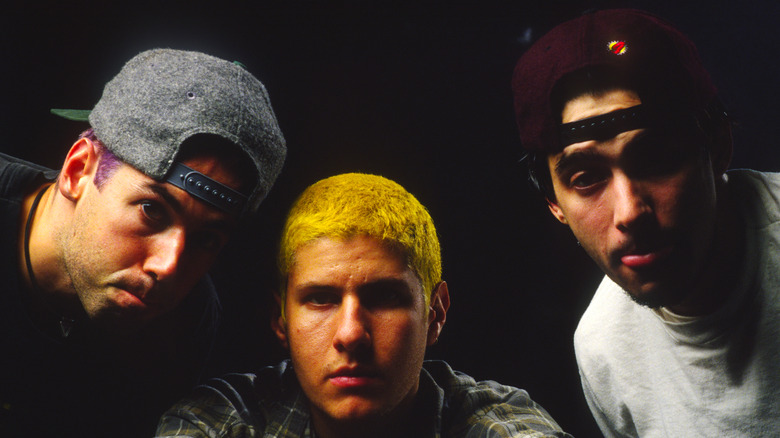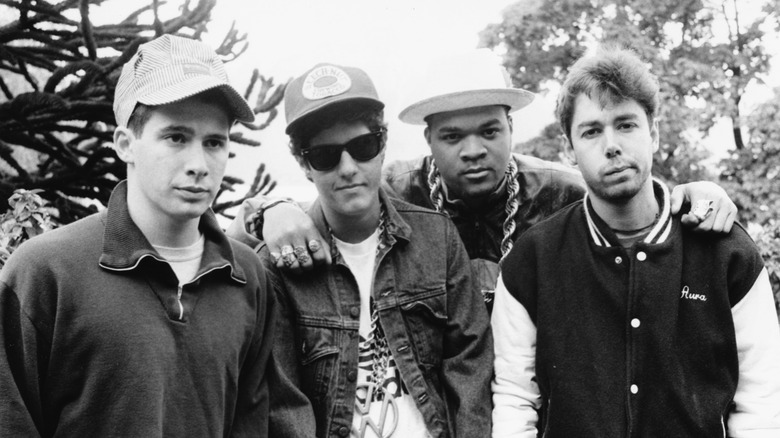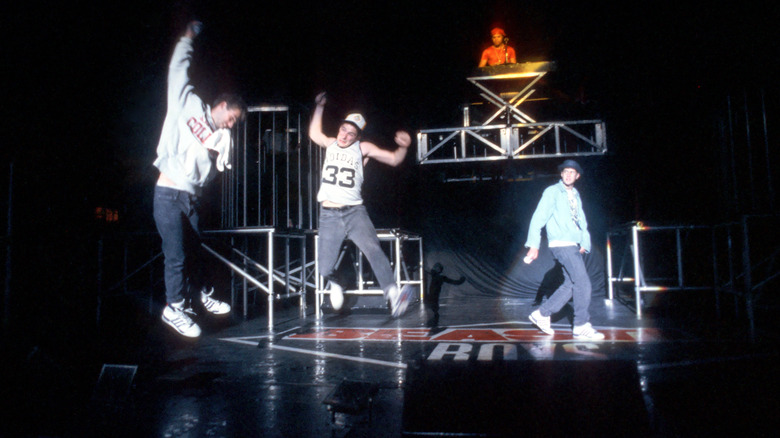The Story Behind The Beastie Boys Album Paul's Boutique
When the Beastie Boys released their debut album, "Licensed to Ill," in 1986, it made the group and its members — Ad-Rock, MCA, and Mike D — instantly famous and, for many, changed the course of hip-hop forever. Following in the footsteps of Run-DMC by incorporating rock samples — often ironically — that were familiar to the ears of white American audiences, the Beastie Boys' breakthrough blurred the lines of the hip-hop genre and created a vast listenership in the process. According to udiscovermusic, the album's commercial success is like no other in the world of hip-hop: It was the first album from the genre to top the Billboard 200 (which it did in March 1987, per the same source), and by 2015 was certified diamond for U.S. sales in excess of 10 million units. No other rap album from the same decade has ever sold more copies.
However, the Beastie Boys' fame came at a price. In producing hits such as the hard rock parody anthem "(You Gotta) Fight For Your Right (To Party!)" and the Led Zeppelin-sampling "Rhymin' & Stealin'," the group had become synonymous with the hard-rocking, beer-swilling, frat-boy image that, for the most part, they had been presenting ironically. "The only thing that upsets me is that we might have reinforced certain values of some people in our audience when our own values were actually totally different. There were tons of guys singing along to ['Fight for Your Right'] who were oblivious to the fact it was a total goof on them," remembered Mike D, via Beastiemania. According to Albumism, the Beastie Boys ended their international tour in support of the album aware of the "self-parody that [they] had become," and that it was time to make a change.
The Beastie Boys and second album syndrome
The Beastie Boys came down from the high of their breakthrough debut album with an almighty crash. As Dan LeRoy's book of their sophomore album describes, the novelty aspects of their earliest work saw them considered little more than "one-hit wonders." Almost immediately, they began to drift away from those who had helped form their image: their producer Rick Rubin and his record label, Def Jam, which helped make the Beastie Boys a household name.
The Beastie Boys were at risk of what is known in the music industry as "difficult second album syndrome," resulting from the pressure to replicate the runaway success of an album the popularity of which is inherently impossible to explain or recreate, per The Guardian.
Rolling Stone reports that following their leaving of the Def Jam label, the native New Yorkers relocated to L.A., where, through local DJ Matt Dike, they were introduced to the music of an up-and-coming production duo, the Dust Brothers. Dike, the source reports, gave Ad-Rock and co. a tape containing the producers' recent beats, which the group immediately snapped up for their upcoming project as the backing for the now-classic tunes "Shake Your Rump" and "Car Thief."
Per Classic Album Sundays, the Dust Brothers were experienced in producing innovative hip-hop instrumentals created through layered sampling for the likes of Tone Loc and Young MC, and thus seemed a perfect working partner through whom the Beastie Boys — who had by now signed to Capitol Records — could establish their hip-hop credentials.
Paul's Boutique: a sampling masterclass
Usually, seminal albums arrive with a bang; critics and fans alike marvel at the brilliance of a group's latest release, and riding a wave of acclaim, the record flies up to the top of the charts to become the defining sound of the moment. However, the 1989 release of "Paul's Boutique" — which the Dust Brothers' John King described as a "labor of love" per KEXP — was quite different.
Hip-hop is now known for its surfeit of imaginative samples — "flipping" a beat and interlacing it with snippets of other records is now common practice. But in 1988, "Paul's Boutique" — which contains between 100 and 300 individual samples, according to the Dust Brothers' Mike Simpson, per The Vinyl Factory — pushed the boundaries of the practice. While it achieved plenty of critical praise at the time and helped the Beastie Boys recast themselves as credible artists, the muted commercial performance after its release in comparison to its predecessor was certainly a disappointment for many involved, according to King.
As explained by Dan LeRoy, the timing of the release of "Paul's Boutique" didn't help, arriving as it did just a few short months after De La Soul's "3 Feet High and Rising," a "sample-heavy, Day-Glo masterpiece" that seemed to beat the Beastie Boys and Dust Brothers to the punch in terms of sampling technique. However, "Paul's Boutique" is now rightly remembered as one of the most inventive and important in hip-hop history.


